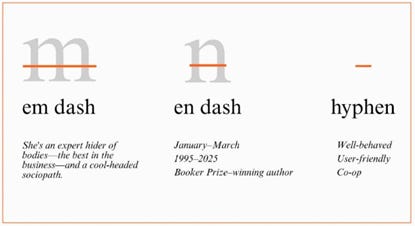The case for the em dash
Style is important for writers—don't you think?
I’ve relied on the em dash for years. It’s not just punctuation—it’s a stylistic choice that adds clarity and emphasis. Yet lately, every time I use one, reviewers strip it out and swap it with a comma.
The reason? ChatGPT. Because the AI leans heavily on em dashes, some assume their presence signals machine-written text. But that’s a mistake. We cannot let algorithms dictate the rules of style. Writers deserve the freedom to use established, legitimate tools without suspicion. The em dash is part of our language’s history, not a glitch to be corrected. To let AI reshape writing etiquette is to hand over authority that belongs to human authors and editors.
A dash of history
The em dash is a punctuation mark with well-entrenched roots and a legacy to match. Although medieval scribes used long strokes to indicate pauses or breaks in thought, the em dash emerged as a standard during the 15th-century printing revolution. And they became popularized by authors like Laurence Sterne and Emily Dickinson in the 18th and 19th centuries. Dickinson used them to convey emotion, hesitation, and for rhythm. So much so, they were called “Dickinson Dashes.”
Around this time, printers began delineating dash lengths, and thus came the various options: em, en, and the hyphen.
Photo courtesy of the author.
In the 19th and 20th centuries, typewriters made these variations tricky. There was no em dash key—just the hyphen. Two hyphens then became the accepted em dash, which was formalized in the digital era, in which word processors automatically convert two hyphens to an em dash.
While there are different standards and styles for spacing and usage, the em dash is a significant form of punctuation. It has a rich history—one more deserving than I offer here. But alas, sometimes knowing just a little about a topic is sufficient. However, here is a great Substack article about the em dash by Thao Thai.
To dash or not to dash?
Although there will be perpetual doubt as to whether Shakespeare actually authored his body of work, he at least is not accused of using AI to write his eloquent masterpieces. (He did use a lot of em dashes, though.) This is simply the age in which writers live. A year from now, another element of our writing might be under scrutiny thanks to AI’s prevalence.
So, to all Hardos, writers, reviewers, and readers, don’t let AI take away a beloved piece of punctuation–before it’s too late!
John Geracitano is a U.S. Army Signal officer and LTG(R) Dubik Writing Fellow currently serving as a doctoral student at the University of North Carolina at Chapel Hill.




Long live the em dash!
Use the em dash with purpose:
https://tjlythgoe.substack.com/p/punctuating-with-purpose